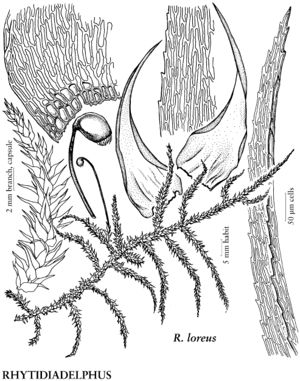Rhytidiadelphus loreus
Krypt.-Fl. Brandenburg 2: 922. 1906.
Plants to 15 cm, soft. Stems 3–5 mm wide across leafy stem, remotely and irregularly branched to subpinnate, branches to 4 cm. Stem-leaves erect-spreading, often falcate-secund or recurved distally, not crowded, ovatelanceolate, plicate, not rugose, 3.2–4.2 × 0.9–1.4 mm; base loosely sheathing, not rounded to insertion; apex abruptly narrowed, acumen long, slender, channeled; costa less than 1/4 leaf length; alar cells not differentiated; medial laminal cells 40–80 × 5–7 µm, smooth. Branch leaves narrowly lanceolate, 1.7–3.6 × 0.4–1 mm. Capsule ovoid, 1.3–2.5 mm.
Habitat: Especially common on logs, but also covering soil, humus, rock, and base of trees, floor of moist coniferous forests, abundant near coast, rare elsewhere
Elevation: low to moderate elevations (0-1000 m)
Distribution

St. Pierre and Miquelon, B.C., N.B., Nfld. and Labr. (Nfld.), N.S., Que., Alaska, Calif., Idaho, Mass., Mont., Oreg., Wash., Europe, Atlantic Islands
Discussion
A specimen of Rhytidiadelphus loreus from Owen Sound, Ontario (Moxley, July 1925, DUKE) is correctly determined, but the locality is very doubtful. In Quebec, R. loreus is known only from the Magdalen Islands in the Gulf of St. Lawrence. The branches of R. loreus decrease regularly in length distally on the stem.
Selected References
None.
Lower Taxa
"nearly" is not a number. "single" is not a number."broad" is not a number.
